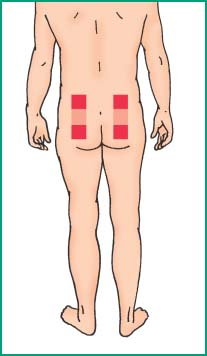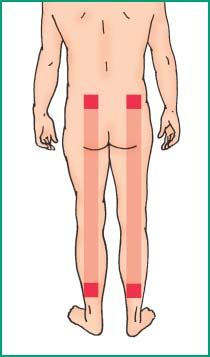Transcutaneous Electrical Nerve Stimulation
Transcutaneous electrical nerve stimulation (TENS) is defined as the application of electrical stimulation to the skin for pain relief. It’s based on the gate-control theory of pain, which proposes that painful impulses pass through a “gate” in the brain. TENS is performed with a portable, battery-powered device that transmits painless electrical current to peripheral nerves or directly to a painful area over relatively large nerve fibers. This treatment effectively alters the patient’s perception of pain by blocking painful stimuli traveling over smaller fibers.
Used for postoperative patients and those with chronic pain, TENS reduces the need for analgesic drugs and may allow the patient to resume normal activities. Typically, a course of TENS treatments lasts 3 to 5 days. Some conditions, such as phantom limb pain, may require continuous stimulation; other conditions, such as a painful arthritic joint, require shorter periods (3 to 4 hours). TENS has also been found to decrease knee pain associated with osteoarthritis. However, recent studies have shown TENS isn’t helpful in patients with chronic lower back pain.1 (See Current uses of TENS.)
TENS is contraindicated for patients with cardiac pacemakers because it can interfere with pacemaker function. The procedure is also contraindicated for pregnant patients because its effect on the fetus is unknown. It’s also contraindicated in patients with dementia. TENS should be used cautiously in all patients with cardiac disorders. TENS electrodes shouldn’t be placed on the head or neck of patients with vascular or seizure disorders.
Positioning Tens Electrodes
With transcutaneous electrical nerve stimulation (TENS), electrodes placed around peripheral nerves (or an incisional site) transmit mild electrical pulses to the brain. The current is thought to block pain impulses. The patient can influence the level and frequency of his pain relief by adjusting the controls on the device.
Typically, electrode placement varies even though patients may have similar complaints. Electrodes can be placed in several ways:
to cover the painful area or surround it, as with muscle tenderness or spasm or painful joints
to “capture” the painful area between electrodes, as with incisional pain.
With peripheral nerve injury, electrodes should be placed proximal to the injury (between the brain and the injury site) to avoid increasing pain. Placing electrodes in a hypersensitive area also increases pain. In an area lacking sensation, electrodes should be placed on adjacent dermatomes.
The illustrations show combinations of electrode placement (red squares) and areas of nerve stimulation (shaded pink) for lower back and leg pain.
 |
 |
 |
Equipment
TENS device ▪ pregelled, self-stick electrodes ▪ warm water and soap ▪ leadwires ▪ charged battery pack ▪ battery recharger ▪ Optional: alcohol pads, hypoallergenic tape.
Commercial TENS kits are available. They include the stimulator, leadwires, electrodes, spare battery pack, battery recharger, and sometimes the adhesive patch.
Preparation of Equipment
Before beginning the procedure, always test the battery pack to make sure it’s fully charged.
Implementation
Verify the doctor’s order.

Stay updated, free articles. Join our Telegram channel

Full access? Get Clinical Tree


Get Clinical Tree app for offline access
